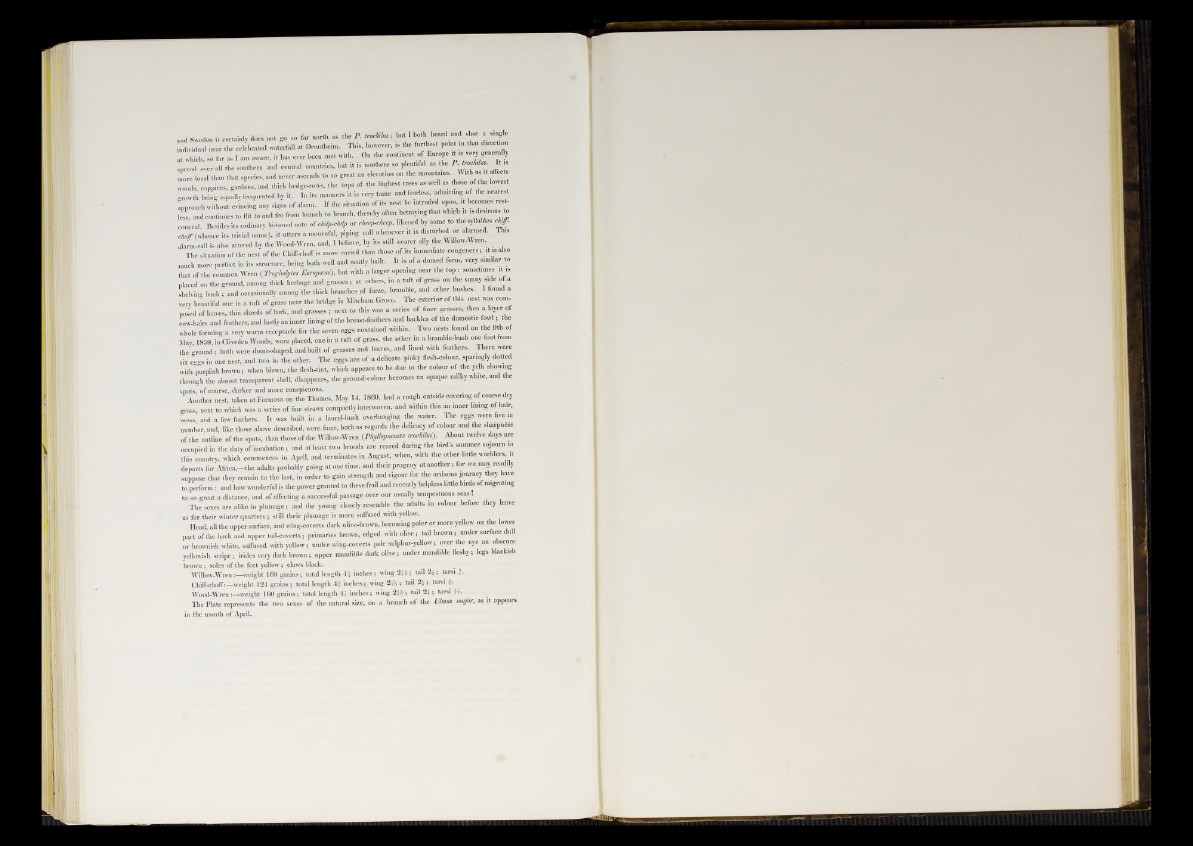
and Swede,, I certainly does not go so far north as the P . I B hut I both heard and shot a single
individual near the celebrated waterfall at Drontheim. This, however, ,s the farthest pomt m that d,reel,on
at which so far as I an, aware, it has ever been met with. On the comment of Europe ,t is very generally
spread over all the southern and central countries, ha t if H nowhere so pleat,ful as the | | | M I t g
more local than that species, and never ascends to so great an elevation on the mounts,ns. | g g g g g | g g
woods, coppices, gardens, and thick hedge-rows, the tops of the highest trees as well as those of the lowes
growth being equally frequented by it. In its manners it is very tame and fearless, admitting of the nearest
approach wMiout evincing any signs of alarm. If the situation of its nest be intruded upon ,t becomes restless,
and continues to Sit to and fro from branch to branch, thereby often betraying that w h i c h |
conceal Besides its ordinary bi-toned note of chilp-chilp or cheep-cheep, likened by some to the syllab es cfof-
c/>af(y,hence its trivial name), it utters a mournful, piping call whenever it is B O alarmed. Th,s
alarm-call is also uttered by the Wood-Wren, and, I believe, by its still nearer ally the Willow-Wren
The situation of the nest of the Chiff-chaff is more varied than those of its immediate congeners; it is also
much more perfect in its structure, being both well and neatly built. I t is of a domed form, very similar to
that of the common Wren (Troglodytes M but with a larger openmg near the top t sometimes ,1 »
placed on the ground, among thick herbage and grasses; at others, in a tuft of grass on the sunny side of a
shelving h an k ; and occasionally among the thick branches of furze, bramble, and other bushes. I found a
very beautiful one in a tnft of grass near the bridge in Mitcham Grove. The exterior of tins nest was com-
posed of leaves, thin shreds of bark, and grasses ; next to this was a series of finer grasses, then a layer of
cow-hairs and feathers, and lastly an inner lining of the breast-feathers and hackles of the domestic fowl , the
whole forming a very warm receptacle for the seven eggs contained within. Two nests found on the 9th of
May 1859 in Cliveden Woods, were placed, one in a tuft of grass, the other in a bramble-bush one foot from
the ground; both were dome-shaped, and built of grasses and leaves, and lined with feathers. There were
six eggs in one nest, and two in the other. The eggs are of a delicate pinky flesh-colour, sparingly dotted
with purplish brown; when blown, the flesh-tmt, which appears to be due to the colour of the yelk showing
through the almost transparent shell, disappears, the ground-colour becomes an opaque milky wlute, and the
spots, of course, darker and more conspicuous.
Another nest, taken at Formosa on the Thames, May 14, 1860, had a rough outside covering of coarse dry
grass next to which was a series of fine straws compactly interwoven, and within this an inner lining of liair,
moss, and a few feathers. I t was built in a laurel-bush overhanging the water. The eggs were five in
number and, like those above described, were finer, both as regards the delicacy of colour and the sharpness
of the outline of the spots, than those of the Willow-Wren (PkyUopneoste IrocMus). About twelve days are
occupied in the duty of incubation ; and at least two broods are reared during the bird's summer sojourn jm
this country, which commences in April, and terminates in August, when, with the other little warblers ,t
departs for Africa,—the adults probably going at one time, and their progeny at another; for we may readily
suppose that they remain to the last, in order to gain strength and vigour for the arduous journey they have
to perform: and how wonderful is the power granted to these frail and recently helpless little birds of migrating
to so great a distance, and of effecting a successful passage over our usually tempestuous seasd
The sexes are alike in plumage; and the young closely resemble the adults in colour before they leave
us for their winter quarters ; still their plumage is more suffused with yellow.
Head, all the upper surface, and wing-coverts dark olive-brown, becoming paler or more yellow on the lower
part of the back and upper tail-coverts; primaries brown, edged with olive; tail brown; under surface dull
or brownish white, suffused with yellow; under wing-coverts pale sulphur-yellow; over the eye an obscure
yellowish stripe; ¡rides very dark brown; upper mandible dark olive; under mandible fleshy; legs blackish
brown ; soles of the feet yellow; claws black.
Willow-Wren:—weight 160 grains; total length 4 f inches; wing 214; 2+j ^ rs* M
Chiif-chaff:—weight 124 grains; total length 4* inches; wing 2-¡V; tail 2+ ; tarsi }.
W o o d -W re nw e ig h t 160 grains; total length A \ inches; wing 214; tail 2 i ; tarsi 14.
The Plate represents the two sexes of the natural size, on a branch of the Ulmus major, as it appears
in the month of April.